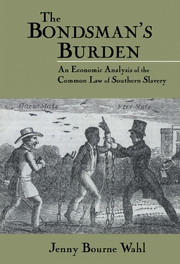Book contents
- Frontmatter
- Contents
- Acknowledgments
- 1 American Slavery and the Path of the Law
- 2 The Law of Sales: Slaves, Animals, and Commodities
- 3 The Law of Hiring and Employment: Slaves, Animals, and Free Persons
- 4 The Law Regarding Common Carriers: Slaves, Animals, Commodities, and Free Persons
- 5 The Law Regarding Governments, Government Officials, Slave Patrollers, and Overseers: Protecting Private Property versus Keeping Public Peace
- 6 The Legal Rights and Responsibilities of Strangers Toward Slaves, Animals, and Free Persons
- 7 Treatment of One's Slaves, Servants, Animals, and Relatives: Legal Boundaries and the Problem of Social Cost
- 8 The South's Law of Slavery: Reflecting the Felt Necessities of the Time
- Notes
- Index
3 - The Law of Hiring and Employment: Slaves, Animals, and Free Persons
Published online by Cambridge University Press: 24 October 2009
- Frontmatter
- Contents
- Acknowledgments
- 1 American Slavery and the Path of the Law
- 2 The Law of Sales: Slaves, Animals, and Commodities
- 3 The Law of Hiring and Employment: Slaves, Animals, and Free Persons
- 4 The Law Regarding Common Carriers: Slaves, Animals, Commodities, and Free Persons
- 5 The Law Regarding Governments, Government Officials, Slave Patrollers, and Overseers: Protecting Private Property versus Keeping Public Peace
- 6 The Legal Rights and Responsibilities of Strangers Toward Slaves, Animals, and Free Persons
- 7 Treatment of One's Slaves, Servants, Animals, and Relatives: Legal Boundaries and the Problem of Social Cost
- 8 The South's Law of Slavery: Reflecting the Felt Necessities of the Time
- Notes
- Index
Summary
Slave hiring was common in the South. Slaves' mobility and intelligence helped them adapt to different jobs, locations, and supervisors, so masters could benefit from hiring out slaves when work was slow at home. Yet these same attributes tempted people to exploit hired slaves when unexpected needs or profit opportunities arose. And slaves, being only human, were sometimes careless and disobedient. Consequently, clashes between slave employers and masters often landed in Southern courts. In keeping with the twofold nature of slaves as property and as humans, antebellum judges drew upon principles established in two broad areas of law to design rules governing slave hiring: the law of hired chattels (especially animals) and the law of employers and employees. The result was a set of rules that enhanced the operation of slave-hiring markets.
But slave-hiring law not only reflected other areas of law, it also served as an important influence. Slave-hiring cases provided precedents for many lawsuits involving livestock or free workers. In other instances, Southern judges developed reasoning in slave cases that later appeared in other types of employment disputes. What follows is, first, an overview of the similarities and differences in laws. Next, the analysis turns to cases in which employers and property owners fixed the terms of their agreements. The chapter ends with a discussion of disputes where courts played a more active role in determining the intentions of parties involved in an employment relationship.
Perhaps the most important finding is this: Although slaves and free workers both faced legal duties to behave like “reasonable persons,” slaveowners recovered damages for injuries far more often than free workers. I offer two explanations for this finding.
- Type
- Chapter
- Information
- The Bondsman's BurdenAn Economic Analysis of the Common Law of Southern Slavery, pp. 49 - 77Publisher: Cambridge University PressPrint publication year: 1997

